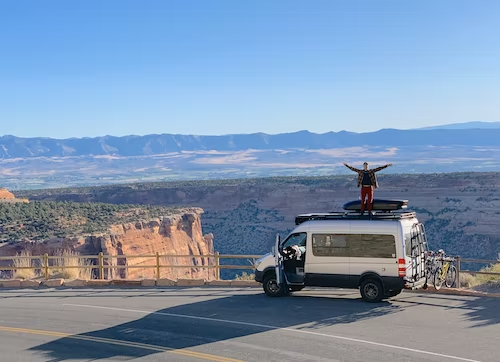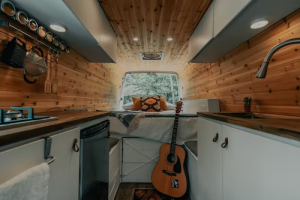The Growing Lifestyle of Van Dwelling

Van life started in the 1960s, and people who were living the untraditional way were known as hippies. Typically this was looked down upon, but since 2011 the community has been growing.
December 16, 2022
Van life has been a growing lifestyle for many people throughout the world. Some enjoy the adventure, and some do it for the beneficial living costs. According to an article published in the New York Times, the Census Bureau estimated that in 2019 there were 140,000 people living in vans, recreational vehicles, or boats. This was a 38% increase from 2016.
“I want to live in a van mostly because of nature and being able to leave society’s norms that are put on us every day. I feel like I can be more who I want to be by myself out in nature,” sophomore Mitchell Lee said.
This growing lifestyle has become more popular especially after Covid-19. Remote jobs have become more common, and people might have more ability to travel. Some have a consistent remote job, or have become social media influencers, while others might simply choose job hopping.
“Ideally, I would want to have a job where I don’t have a particular office. The internet is becoming more advanced by the day, and I would love to be able to do something online while I am living in different places,” senior Lena Miller said.
With the growing economy and expensive housing prices, living in a van has become more affordable for many people. According to SoFi, the average annual living cost in Colorado is $46,642, ranking as the 16th highest state.
According to Nate Murphy’s Van Conversion Guide, it costs about $30,000 to have a van built for you with minimal interior. Paying other people to build your van will cost a lot of money but may be worth it depending on how committed you are to the lifestyle. It can cost up to about $100,000 for a fully renovated van. If you were to build it yourself, it would still cost a lot, but you would have better ability to budget and look around for deals on items to put in your van.
There is no one, right way to renovate the inside of your van or school bus. Therefore, research is definitely necessary for this process. I would recommend looking into multiple social media influencers who live in a van, just to get different perspectives of the lifestyle. I would also recommend watching hundreds of YouTube videos just to make sure you get the build of your van right. Tiny Home Tours on YouTube is a good channel to watch for a little bit of either of these aspects.

The industry has seen growth thanks to companies such as Van Life Customs who help make the renovation of your van a lot easier. Companies like this are usually booked, so it would take awhile to get your van renovated. But, if you don’t know the first thing about renovating the inside of a van into a livable space, and are willing to spend lots of money for someone else to do it, this may be a good option.
“What makes me want to live in a van one day is the idea of not being stuck in one place. I think that it’s a great opportunity to be able to see a lot of different places without having to spend a ton of money on flights,” Miller said.
Living in a van is not easy. The media tends to glorify many aspects of the lifestyle. Just like any other social media post, many influencers post only the good parts. They post waking up with the prettiest views, the endless adventures, all the yummy foods, and all the people they meet along the way. What they don’t show you are the endless obstacles like van troubles, exhaustion, and not knowing where you’re going to sleep every night. The overall spontaneity of living the van life is not as easy as everyone makes it out to be.
How is van life possible? Depending on your van build, hygiene may or may not be easy. Most people have gym memberships and use showers there, and they also use bathrooms at public places. If you invest a little more money into your van, you could have your own bathroom and shower, but you have to be cautious of water usage, so showering as often as you’re used to may not be achievable.
Where can you stay? There are many places. Potential locations include camp sites (which can be free depending if they are KOA campgrounds or not), Walmart parking lots (overnight), or truck stops. Finding parking areas to stay overnight will become easier as you become more educated and adapted to your lifestyle.
Lots of renovated vans include some sort of refrigerator for a little food supply. Van dwellers typically shop day to day for food to keep it simple. Some vans also have built-in stove tops, or they have portable ones. If you are trying to save money, I would recommend eating out as little as possible, so having some type of refrigerator system is recommended.
Before considering this lifestyle, veteran van lifers suggest trying to live out of your car for a week or so in order to determine if this way of living is something you’re really interested in because it is a big commitment. The most important thing to remember, though, is that the nomadic life is not easy, and not everyone is a fit for this. Do adequate research about all aspects before deciding because there are a lot of videos that glorify living in a van. If you’ve done your research and feel prepared, the only way to know for sure is to get out there and explore! Safely, of course.


